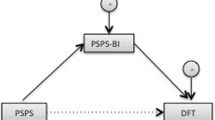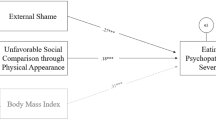Abstract
Shame feelings often lead individuals to adopt compensatory mechanisms, such as the minimization of the public display or disclosure of mistakes and the active promotion of perfect qualities, conceptualized as perfectionistic self-presentation. Although perfectionism is considered a central characteristic of disordered eating, the investigation on the specific domain of body image-related perfectionistic self-presentation and on its relationship with psychopathology is still scarce. The main aim of the present study was exploring the moderator effect of body image-related perfectionistic self-presentation on the associations of shame with depressive symptomatology, and with eating psychopathology, in a sample of 487 women. Results revealed that body image-related perfectionistic self-presentation showed a significant moderator effect on the relationships of external shame with depressive symptomatology, and with eating psychopathology severity, exacerbating shame’s impact on these psychopathological indices. These findings appear to offer important clinical and investigational implications, highlighting the maladaptive character of such body image-focused strategies.



Similar content being viewed by others
References
Lewis HB (1971) Shame and guilt in neurosis. International Universities Press, New York
Tangney JP, Dearing RL (2002) Shame and Guilt. Guilford Press, New York
Tracy JL, Robins RW (2004) Putting the self into self-conscious emotions: a theoretical model. Psychol Inq 15:103–125. doi:10.1207/s15327965pli1502_02
Allan S, Gilbert P, Goss K (1994) An exploration of shame measures-II: psychopathology. Personal Individ Differ 17:719–722. doi:10.1016/0191-8869(94)90150-3
Goss K, Gilbert P, Allan S (1994) An exploration of shame measures-I: the other as shamer scale. Personal Individ Differ 17(5):713–717. doi:10.1016/0191-8869(94)90149-X
Cook DR (1996) Empirical studies of shame and guilt: the internalized shame scale. In: Nathanson DL (ed) Knowing feeling: affect, script and psychotherapy. Norton, New York, pp 132–165
Gilbert P (2002) Body shame: a biopsychosocial conceptualisation and overview, with treatment implications. In: Gilbert P, Miles J (eds) Body shame: conceptualisation, research and treatment. Routledge, London, pp 3–54
Gilbert P (2003) Evolution, social roles and the differences in Shame and Guilt. Soc Res 70(4):1205–1230
Lewis M (1992) Shame: the exposed self. The Free Press, New York
Tangney J, Wagner P, Gramzow R (1992) Proneness to shame, proneness to guilt and psychopathology. J Abnorm Psychol 101:469–478. doi:10.1037/0021-843X.101.3.469
Hennig-Fast K, Michl P, Müller J, Niedermeier N, Coates U, Müller N, Engel RR, Möller HJ, Reiser M, Meindl T (2015) Obsessive-compulsive disorder : a question of conscience? An fMRI study of behavioural and neurofunctional correlates of shame and guilt. J Psychiatr Res 68:354–362. doi:10.1016/j.jpsychires.2015.05.001
Lamont JM (2015) Trait body shame predicts health outcomes in college women: a longitudinal investigation. J Behav Med. doi:10.1007/s10865-015-9659-9
Gilbert P, Allan S, Goss K (1996) Parental representations, shame, interpersonal problems, and vulnerability to psychopathology. Clin Psychol Psychother 3:23–34. doi:10.1002/(SICI)1099-0879(199603)3:1<23:AID-CPP66>3.0.CO;2-O
Pinto-Gouveia J, Matos M (2011) Can shame memories become a key to identity? The centrality of shame memories predicts psychopathology. Appl Cogn Psychol 25:281–290. doi:10.1002/acp.1689
Burney J, Irwin HJ (2000) Shame and guilt in women with eating disorder symptomatology. J Clin Psychol 56:51–61. doi:10.1002/(SICI)1097-4679(200001)56:1<51:AID-JCLP5>3.0.CO;2-W
Goss K, Gilbert P (2002) Eating disorders, shame and pride: a cognitive-behavioural functional analysis. In: Gilbert P, Miles J (eds) Body shame: conceptualisation, research and treatment. Brunner-Routledge, New York, pp 219–255
Mustapic J, Marcinko D, Vargek P (2015) Eating behaviours in adolescent girls: the role of body shame and body dissatisfaction. Eat Weight Disord 20(3):329–335. doi:10.1007/s4051901501832
Pinto-Gouveia J, Ferreira C, Duarte C (2014) Thinness in the pursuit of social safeness: an integrative model of social rank mentality to explain eating psychopathology. Clin Psychol Psychother 21:154–165. doi:10.1002/cpp.1820
Troop NA, Redshaw C (2012) General shame and Bodily Shame in eating disorders: a 2.5-year longitudinal study. Eur Eat Disord Rev 20:373–378. doi:10.1002/erv.2160
Gee A, Troop NA (2003) Shame, depressive symptoms and eating, weight and shape concerns in a non-clinical sample. Eat Weight Disord 8(1):72–75. doi:10.1007/BF03324992
Murray C, Waller G, Legg C (2000) Family dysfunction and bulimic psychopathology: the mediating role of shame. Int J Eat Disord 1:84–89
Cooper MJ, Todd G, Wells A (1998) Content, origins and consequences of dysfunctional beliefs in anorexia nervosa and bulimia nervosa. J Cogn Psychother 12:213–230
Grabhorn R, Stenner H, Stangier U, Kaufhold J (2006) Social anxiety in anorexia and bulimia nervosa: the mediating role of shame. Clin Psychol Psychother 13:12–19. doi:10.1002/cpp.463
Ferreira C, Trindade IA, Ornelas L (2015) Exploring drive for thinness as a perfectionistic strategy to escape from shame experiences. Span J Psychol 18:E29. doi:10.1017/sjp.2015.27
Cheung MSP, Gilbert P, Irons C (2004) An exploration of shame, social rank and rumination in relation to depression. Personal Individ Differ 36:1143–1153. doi:10.1016/S0191-8869(03)00206-X
Tangney JP, Burggraf SA, Wagner PE (1995) Shame-proneness, guilt-proneness, and psychological symptoms. In Self-Conscious Emotions. In: Tangney JP, Fischer KW (eds) The Psychology of Shame, Guilt, embarrassment and pride. NewYork, Guilford, pp 343–367
Gilbert P (2000) The relationship of shame, social anxiety and depression: the role of the evaluation of social rank. Clin Psychol Psychother 7(3):174–189. doi:10.1002/1099-0879(200007)7:3<174:AID-CPP236>3.0.CO;2-U
Allan S, Gilbert P (1995) A Social Comparison Scale: psychometric properties and relationship to psychopathology. Personal Individ Differ 19:293–299. doi:10.1016/0191-8869(95)00086-L
Gilbert P, Price J, Allan S (1995) Social comparison, social attractiveness and evolution: how might they be related? N Ideas Psychol 13:149–165. doi:10.1016/0732-118X(95)00002-X
Hewitt PL, Flett GL, Sherry SB, Habke M, Parkin M, Lam RW, McMurtry B, Ediger E, Fairlie P, Stein MB (2003) The interpersonal expression of perfection: perfectionistic self-presentation and psychological distress. J Pers Soc Psychol 84(6):1303–1325. doi:10.1037/0022-3514.84.6.1303
Hewitt PL, Flett GL, Ediger E (1996) Perfectionism and depression: longitudinal assessment of a specific vulnerability hypothesis. J Abnorm Psychol 105(2):276–280. doi:10.1037/0021-843X.105.2.276
Mackinnon SP, Sherry SB (2012) Perfectionistic self-presentation mediates the relationship between perfectionistic concerns and subjective well-being: a three-wave longitudinal study. Personal Individ Differ 53:22–28. doi:10.1016/j.paid.2012.02.010
Cockell SJ, Hewitt PL, Seal B, Sherry S, Goldner EM, Flett GL, Remick RA (2002) Trait and self-presentational dimensions of perfectionism among women with anorexia nervosa. Cogn Ther Res 26(6):745–758. doi:10.1023/A:102123741636
Hewitt PL, Flett GL, Ediger E (1995) Perfectionism traits and perfectionistic self-presentation in eating disorder attitudes, characteristics, and symptoms. Int J Eat Disord 18(4):317–326. doi:10.1002/1098-108X(199512)18:4<317:AID-EAT2260180404>3.0.CO;2-2
McGee B, Hewitt P, Sherry S, Parkin M, Flett G (2005) Perfectionistic self-presentation, body image, and eating disorder symptoms. Body Image 2:29–40. doi:10.1016/j.bodyim.2005.01.002
Steele AL, O’Shea A, Murdock A, Wade TD (2011) Perfectionism and its relation to overevaluation of weight and shape and depression in an eating disorder sample. Int J Eat Disord 44:459–464. doi:10.1002/eat.20817
Gatward N (2007) Anorexia nervosa: an evolutionary puzzle. Eur Eat Disord Rev 1:1–12. doi:10.1002/erv.718
Sypeck MF, Gray JJ, Etu SF, Ahrens AH, Mosimann JE, Wiseman CV (2006) Cultural representations of thinness in women, redux: playboy magazine´s depictions of beauty from 1979 to 1999. Body Image 3(3):229–235. doi:10.1016/j.bodyim.2006.07.001
Strahan EJ, Wilson AE, Cressman KE, Buote VM (2006) Comparing to perfection: how cultural norms for appearance affect social comparisons and self-image. Body Image 3:211–227. doi:10.1016/j.bodyim.2006.07.004
Tiggemann M, Lynch JE (2001) Body image across the life span in adult women: the role of self-objectification. Dev Psychol 37(2):243–253. doi:10.1037/0012-1649.37.2.243
Spettigue W, Henderson KA (2004) Eating disorders and the role of the media. Can Child Adolesc Psychiatr Rev 1:16–19
Anton SD, Perri MG, Riley JR (2000) Discrepancy between actual and ideal body images: impact on eating and exercise behaviors. Eat Behav 1(2):153–160. doi:10.1016/S1471-0153(00)00015-5
Stice E, Shaw HE (1994) Adverse effects of the media portrayed thin-ideal on women and linkages to bulimic symptomatology. J Soc Clin Psychol 13(3):288–308. doi:10.1521/jscp.1994.13.3.288
Fairburn CG, Beglin SJ (1994) Assessment of eating disorders: interview or self-report questionnaire? Int J Eat Disord 4:363–370. doi:10.1002/1098-108X(199412)16:4%3c363:AID-EAT2260160405%3e3.0.CO;2-#
Machado PP, Martins C, Vaz AR, Conceição E, Bastos AP, Gonçalves S (2014) Eating disorder examination questionnaire: psychometric properties and norms for the Portuguese population. Eur Eat Disor Rev 22(6):448–453. doi:10.1002/erv.2318
Lovibond PF, Lovibond SH (1995) The structure of negative emotional states: comparison of the Depression Anxiety Stress Scales (DASS) with the Beck Depression and Anxiety Inventories. Behav Res Ther 3:335–343
Pais-Ribeiro JL, Honrado A, Leal I (2004) Contribuição para o estudo da adaptação Portuguesa das Escalas de Ansiedade, Depressão e Stress (EADS-21). Psychologica 36:235–246
Cohen J, Cohen P, West S, Aiken L (2003) Applied multiple regression/correlation analysis for the behavioural sciences, 3rd edn. Lawrence Erlbaum Associates, New Jersey
Aiken LS, West SG (1991) Multiple regression: testing and interpreting interactions. Newbury Park, London, Sage
WHO (1995) Physical status: the use and interpretation of anthropometry. Reports of a WHO Expert Commitee. WHO Technical Report series 854. Geneva, World Health Organization
Poínhos R, Franchini B, Afonso C, Correia F, Teixeira VH, Moreira P, Durão C, Pinho O, Silva D, Lima Reis JP, Veríssimo T, de Almeida MDV (2009) Alimentação e estilos de vida da população portuguesa: metodologia e resultados preliminares. Alimentação Humana 15(3):43–61
Author information
Authors and Affiliations
Corresponding author
Ethics declarations
Conflict of interest
The authors of this manuscript declare no conflict of interest.
Ethical approval
All procedures performed in studies involving human participants were in accordance with the ethical standards of the institutional research committee and with the 1964 Helsinki declaration and its later amendments or comparable ethical standards.
Informed consent
Informed consent was obtained from all individual participants included in the study.
Rights and permissions
About this article
Cite this article
Marta-Simões, J., Ferreira, C. Seeking a perfect body look: feeding the pathogenic impact of shame?. Eat Weight Disord 21, 477–485 (2016). https://doi.org/10.1007/s40519-015-0240-x
Received:
Accepted:
Published:
Issue Date:
DOI: https://doi.org/10.1007/s40519-015-0240-x




